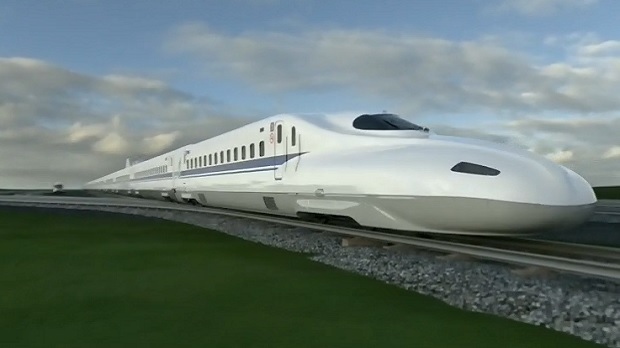Infra
High-Speed Rail to Solve Housing, Congestion and Growth

As Ontario’s housing crisis deepens, with GTA home prices averaging $1.1 million and congestion costing the region’s economy $11 billion annually, the solution may lie in expanding the province’s transportation infrastructure. A robust high-speed rail network could simultaneously alleviate housing pressures, boost economic productivity, and reshape growth across Ontario.
Congestion and Commute Times: An Urgent Problem
The average commute time for Toronto residents is now 1 hour 24 minutes per day, with public transit riders spending 43 minutes per trip—one of the longest in North America (Ontario Government) (Daily Hive Vancouver). The region’s congestion not only impacts quality of life but also puts strain on local infrastructure. Addressing this challenge with faster, more efficient transit options, such as high-speed rail, could greatly alleviate this burden.
High-Speed Rail as a Housing and Transit Solution
Imagine a high-speed rail network connecting Toronto to cities such as North Bay, Sudbury, Windsor, and Ottawa, traveling at speeds of 300 km/h. Commutes that currently take hours by car would be cut dramatically:
- Toronto to North Bay: 347 km, 1 hour 9 minutes.
- Toronto to Sudbury: 414 km, 1 hour 23 minutes.
- Toronto to Windsor: 365 km, 1 hour 13 minutes.
- Toronto to Ottawa: 450 km, 1 hour 30 minutes.
These significantly reduced travel times make cities like North Bay, Sudbury, and Windsor viable alternatives for homebuyers priced out of the GTA market. Not only would high-speed rail ease commutes, but it would also encourage regional growth by unlocking access to more affordable housing.
For instance:
- North Bay: Average home price of $410,000 (62% lower than Toronto).
- Sudbury: Average price of $395,000 (64% lower than Toronto).
- Windsor: $550,000 (50% lower than Toronto).
As commutes from cities like North Bay, Sudbury, and Windsor become feasible—thanks to high-speed rail—residents could live in these more affordable markets while still accessing the GTA for work.
Introducing the Ontario High-Speed Rail Network: Connecting the Province
The proposed “Ontario High-Speed Rail Network” includes four main lines that would connect the majority of the province, excluding only the most remote northern cities. With trains reaching speeds of 300 km/h, commuting times would be slashed, unlocking affordable housing markets while maintaining access to the GTA’s job centers. Here’s a breakdown of the proposed lines:
- Line 1: Toronto to Ottawa via Kingston and Peterborough
- Distance: 450 km
- Cost:
- At $25M/km: $11.25 billion
- At $50M/km: $22.5 billion
- Line 2: Toronto to Windsor via Pearson Airport, Kitchener/Waterloo, and London
- Distance: 360 km
- Cost:
- At $25M/km: $9 billion
- At $50M/km: $18 billion
- Line 3: Toronto to North Bay and Sudbury via Barrie
- Total Distance: 590 km
- Cost:
- At $25M/km: $14.75 billion
- At $50M/km: $29.5 billion
- Line 4: Ottawa to Sudbury via Pembroke and North Bay
- Distance: 700 km
- Cost:
- At $25M/km: $17.5 billion
- At $50M/km: $35 billion
In total, the Ontario High-Speed Rail Network would span roughly 2,100 km. The estimated total construction cost would range between $52.5 billion to $105 billion depending on the final cost per kilometer.
Economic Costs of Congestion vs. Investment in Rail
The GTHA faces a growing problem: congestion currently costs the region’s economy $11 billion per year. The high-speed rail network, while representing a significant investment, would help reduce the economic drag caused by congestion by decentralizing population growth and creating new economic hubs in smaller cities.
A network costing between $52.5 billion and $105 billion might seem steep, but it could more than pay for itself in terms of reduced congestion, increased economic activity in Ontario’s secondary cities, and a more balanced housing market. Additionally, the network could expand in the future to include remote cities such as Timmins and Sault Ste. Marie, drastically reducing travel times and integrating Northern Ontario with the rest of the province.
The Future of Ontario Lies in Connectivity
By constructing this high-speed rail network, Ontario could take a bold step toward solving the twin crises of housing and congestion. As regions like Kitchener-Waterloo and London grow to million-plus population centers, a connected, accessible province would distribute that growth more equitably. The result would be a stronger, more integrated Ontario with opportunities for all residents, no matter where they live.
This investment could mark the start of a new era for the province—one where economic and population growth isn’t limited to the GTA but is spread across the province through efficient, sustainable infrastructure.









